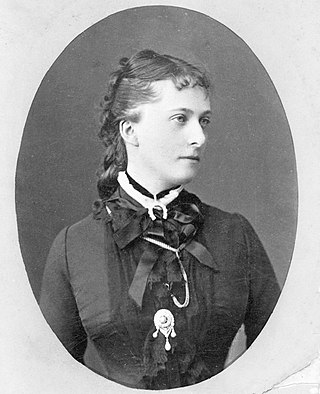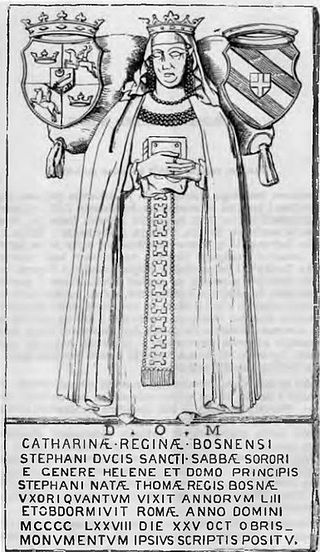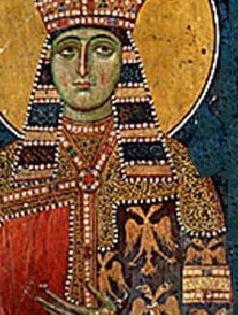
Catherine of Aragon was Queen of England as the first wife of King Henry VIII from their marriage on 11 June 1509 until its annulment on 23 May 1533. She was Princess of Wales while married to Henry's elder brother, Arthur, Prince of Wales, for a short period before his death.
Agrippina is an ancient Roman cognomen and a feminine given name. People with either the cognomen or the given name include:
Queen Catherine may refer to:

Princess Catherine Dolgorukova was a Russian aristocrat and the daughter of Prince Michael Dolgorukov and his wife, Vera Vishnevskaya.

Princess Yekaterina Romanovna Dashkova was an influential noblewoman, a major figure of the Russian Enlightenment and a close friend of Empress Catherine the Great. She was part of the coup d'état that placed Catherine on the throne, the first woman in the world to head a national academy of sciences, the first woman in Europe to hold a government office and the president of the Russian Academy, which she helped found. She also published prolifically, with original and translated works on many subjects, and was invited by Benjamin Franklin to become the first female member of the American Philosophical Society.

The House of Kotromanić was a late medieval Bosnian noble and later royal dynasty. Rising to power in the middle of the 13th century as bans of Bosnia, with control over little more than the valley of the eponymous river, the Kotromanić rulers expanded their realm through a series of conquests to include nearly all of modern-day Bosnia and Herzegovina, large parts of modern-day Croatia and parts of modern-day Serbia and Montenegro, with Tvrtko I eventually establishing the Kingdom of Bosnia in 1377. The Kotromanić intermarried with several southeastern and central European royal houses. The last sovereign, Stephen Tomašević, ruled briefly as Despot of Serbia in 1459 and as King of Bosnia between 1461 and 1463, before losing both countries – and his head – to the Ottoman Turks.

Catherine of Bosnia was Queen of Bosnia as the wife of King Thomas, the penultimate Bosnian sovereign. She was born into the powerful House of Kosača, staunch supporters of the Bosnian Church. Her marriage in 1446 was arranged to bring peace between the King and her father, Stjepan Vukčić. The queenship of Catherine, who at that point converted to Roman Catholicism, was marked with an energetic construction of churches throughout the country.

Christine Marie of France was Duchess of Savoy from 26 July 1630 to 7 October 1637 as the consort of Duke Victor Amadeus I. She was the daughter of Henry IV of France and sister of Louis XIII. Following her husband's death in 1637, she acted as regent of Savoy between 1637 and 1648.
Catherine of Sweden - Swedish: Katarina or Catharina or Karin - may refer to
Elizabeth of Kuyavia was a Polish noblewoman of the House of Piast. She was the only daughter of Duke Kazimierz III of Gniewkowo and his wife, whose name and origins are unknown; her brother, Władysław the White, was later a candidate for the Polish throne.
Ivaniš Nelipić or Ivan III Nelipić was a Croatian nobleman who was prince of Cetina and Omiš. He was also titular Ban of Croatia and Dalmatia in 1419 and was a member of one of the most powerful Croatian noble families at the time. At the peak of his power, he ruled areas in inner Croatia from the mountain of Velebit to the Cetina river. From 1401 to 1435, he ruled over Klis Fortress, although his main seat was at Knin in Knin Fortress. During his reign, he was greatly involved in conflicts over Bosnia. Later, he was also recognized as duke of the Dalmatian cities, specifically Trogir, Split and Skradin.
Katherine is a feminine given name.
Catherine of Bosnia was a Bosnian noblewoman. She was Countess of Cilli by her marriage to Hermann I, Count of Cilli, and a member of the House of Kotromanić by birth.

Elizabeth of Serbia was Baness of Bosnia by her marriage to Stephen I, Ban of Bosnia. Elizabeth briefly ruled as regent for her eldest son, Stephen II, in 1314.
Zahra is a female given name of Arabic origin. The name became popularized as a result of being the name of Muhammad’s daughter, Fatimah al-Zahra.

Helena Palaiologina was a Byzantine princess who married Serbian Despot Lazar Branković, who ruled from 1456 until his death in 1458. After Smederevo fell to the Ottoman Turks on 20 June 1459, she fled Serbia for the Greek island of Lefkada, where she converted to Catholicism.

Kral KızıMausoleum or Kral Kızı Turbe is a türbe dedicated to the Bosnian princess Catherine located in the city of Skopje, North Macedonia, near the Faculty of Natural Sciences and Mathematics of Ss. Cyril and Methodius University. The tomb was reconstructed in 2014 by the Ministry of Culture of Macedonia with financial contribution from the Ministry of Culture and Sports of Bosnia and Herzegovina, after having been destroyed in the 1963 earthquake.
Catherine of Bosnia was a member of the House of Kotromanić and the last Bosnian princess. She was captured during the Ottoman conquest of Bosnia, converted to Islam and spent the rest of her life in the Ottoman Empire. She died and was buried under the Kral Kızı Türbe in the vicinity of modern Skopje.
Princess Catherine may refer to:
This page is based on this
Wikipedia article Text is available under the
CC BY-SA 4.0 license; additional terms may apply.
Images, videos and audio are available under their respective licenses.








